|























|
Romantic Journeys: Kyongju,
Korea’s Ancient Capital
To be Korean is to belong to a land invaded again and again,
a land since 1910 either occupied, or divided by war. Yet its people are among
the purist ethnic strains in Asia. Their spirit has been bruised, but never
broken. Perhaps because Korea is a feeling, a style, a sense. That spirit
germinated in Kyongju, a small city on Korea’s south east coast, where 1,300
years ago Korea became a nation. And for a while, peace and harmony reigned.
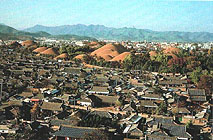 Kyongju,
with its 23 tombs looming over the city, is now a national park Kyongju,
with its 23 tombs looming over the city, is now a national park
At its peak in the eighth century, Kyongju is estimated to
have had a population of nearly one million residents. The king’s four
palaces, one for each season, were draped in luxuries; Philippine tortoise
shell, Persian glass, Japanese pearls. It was said that many foreigners who
came to visit simply forgot to return home. The city, center of the Silla
Dynasty, produced silk-smooth paper which was coveted by the Chinese and bronze
temple bells admired by the Japanese. Its niche in history was as the
birthplace of a nation. By 668 Silla had defeated neighbouring rival kingdoms;
Paekche to the west, Koguryo to the north. Then Silla repelled invasion from
Tang China. Finally Korea was a unified nation.
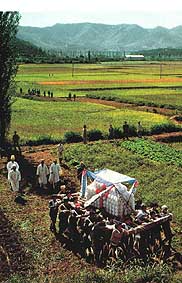 A
Korean family shepherding a coffin to a traditional mound of earth for burial A
Korean family shepherding a coffin to a traditional mound of earth for burial
Today Kyongju’s embrace of tourism has brought changes. In
the 1970s the temples and shrines of the city were renovated, and the Pomun
resort was built. Critics complain about all the concrete, but wood is
expensive. Those who miss the charm of the old, rather shabby Kyongju, remark
that the complex has all of the charm of a barracks.
But there are really two Kyongjus. The first is of tourist
brochures and certainly ‘picture post card pretty’. The jumble of
swaybacked, tile-roofed houses surrounded by rice fields are set at the foot of
the mountains and glisten in the morning mist. The traveller can take a road,
any road. It will invariably lead to a pagoda, shrine or tomb. The other is
Kyongju the holy. It is more difficult to define, for it exists in the spirit
and the heart. A climb up the mountain of Namsan just three miles out of town
will leave you gasping for breath. The trail is studded with some 60 stone
Buddhist figures.
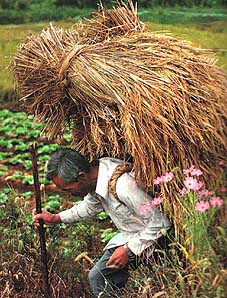 Some
farmers around the ancient capital still find the old methods best Some
farmers around the ancient capital still find the old methods best
Tucking the dead into gently sloping mounds of earth has
been a Korean custom for centuries. The 23 tombs of Sill nobles cluster in a
downtown park. They loom over the city with uncontested majesty. This ancient
city inspired poetry and art. Buddhist thinking created a spiritual people
living in harmony with nature. Buddhist thought flowed into the kingdom in the
sixth century and it still seems to focus on eternity.
The Sheraton Grande: A
Showcase For All Seasons
by Peter Cummins
Pattaya Mail special correspondent
Peter Cummins has been ‘hot-footing’ around the Bangkok social scene
somewhat, bringing the Mail into close contact with some of the events
taking place in the “Big Mango”. Herewith are reports of his three latest
escapades.
The splendid Sheraton Grande Sukhumvit is “all go” these
days, with opera stars Victoria Atwater and Bruce Reed casting a spell over the
huge crowd who attended the spectacular dinner-cum-operatic evening, sponsored
by and reported in the Pattaya Mail (16 November, 2001, Vol. 9, no.46).
A despatch (like, an e-mail) received this week from
Victoria, informed us that they so enjoyed Thailand that they will be back for
another concert when the time is propitious - and that will include a show in
Pattaya. We must be doing something right at the Pattaya Mail!
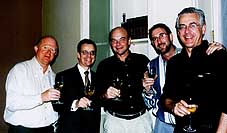 Richard
Chapman, general manager of the Sheraton Grande Sukhumvit (2nd left), tries a
little white Chateauneuf Du Pape with the Rotarians. It is rumoured that
Bangkok South “is a drinking club, with a Rotary problem”. Photo Peter
Cummins Richard
Chapman, general manager of the Sheraton Grande Sukhumvit (2nd left), tries a
little white Chateauneuf Du Pape with the Rotarians. It is rumoured that
Bangkok South “is a drinking club, with a Rotary problem”. Photo Peter
Cummins
Then there was the wine dinner at Rossini’s, an all-French
cuisine and ‘tastevin’ - even though it was held in the Sheraton’s
Italian restaurant. Among the gourmets and wine connoisseurs was a group of
Bangkok South Rotarians-about-town - ‘bon vivants’ in their own right - who
are experts in both fields, resulting from numerous Rotary functions and
“after meeting” sallies around Cosmos and environs of the Patpong area.
The dinner was “nouvelle cuisine” style with, of course,
exotic escargots (snails), grilled tuna loin, braised stuffed duck leg - with
melted garlic - roast rabbit filet ... it went on...and on.
The wines were principally Cote-Du-Rhone, Crozes Hermitage,
Chateuaneuf-Du-Pape and Cote Rotie, a marvellous list of reds and whites, while
the aperitif wine was a refreshing Cote Du Rhone Rose.
Enter, The Bard
The next big event was the performance by Susannah York with
the one-lady monologue, “The Loves of Shakespeare’s Women”. Played to a
packed house, this was truly an electrical evening, as the vivacious Susannah
launched into her routines, at times tragic, at times humorous, at times
dramatic and theatrical - but always riveting.
The audience was regaled with extracts and sonnets culled
from many of the Bard’s works, such as Cleopatra, Katherine of Aragon,
Rosalind from “As you like it” and Beatrice from “Much Ado About
Nothing”.
Love - of whatever kind - is the theme: romantic, parental,
sibling, patriotic, religious, any type of love which has been the underlying
basis of human relationships through time and which, certainly, Shakespeare has
portrayed in his vast range of works. One category which seems to have escaped
the Elizabethan playwright is that of love between mother and daughter. This
puzzles Susannah somewhat and, as she says, “is a good topic in pursuing
Shakespearean studies.
The first appearance of this one-person art form was at this
year’s Edinburgh Festival and was highly acclaimed. Susannah starts each
portrayal with a short introduction to the character, before assuming the role
so that even those who have not studied Shakespeare can easily grasp the
meanings and the subtleties of the particular heroine!
A motivating force behind Ms York’s intensity to promote
Shakespeare - especially his women - has been the announcement of the British
government’s plans to drop Shakespeare from the state school curriculum.
A fine pedigree as an actress herself, this was Ms York’s
first Bangkok appearance and “it will not be my last,” she said. Hopefully,
the next visit will include Pattaya, where many of the Bard’s ‘disciples’
reside.
And, for Christmas...
Finally, as the Yuletide season is almost upon us, the
classic and wonderful masterpiece of Charles Dickens, “A Christmas Carol”
was held on Tuesday the fourth of December (evening) with a matinee on
Wednesday, the fifth of December, His Majesty the King’s birthday.
This was a new adaptation of the timeless story of Tiny Tim,
the Spirits of Christmas and the Grinch who tried to steal Christmas, Ebenezer
Scrooge. Scrooge is the protagonist of ill will and, with the present turmoil
in the world, he could well represent a large segment of mankind, bent upon
destruction and hatred. Perhaps, as in the case of the miserly, misanthropic
Scrooge, some ghosts will appear in our world and, as they did for Scrooge,
change the course of human folly and misery.
Collectively, we could not ask for a better Christmas present.
Friends on the road
by Kathryn Brimacombe
It’s funny how close you can get to total strangers when
you’re travelling. I’ll give you an example. I just got off a nineteen-hour
nightmarish bus journey from Savannakhet in South Laos to Hue in Vietnam. I
knew it wasn’t going to be a fun ride (I’d heard the road across Laos to
the border at Lao Bao, Vietnam, was in terrible shape) - especially when we
were just about to board the bus we saw the driver, huge handfuls of burning
incense sticks clutched in his hands, feverishly praying to the flashing
red-gold-and green Buddha on the dashboard. (Incidentally, this Buddha lit up
like a Christmas tree was the focus of many bleary-eyed exhausted hours during
the night when the driver played Lao/Vietnamese pop music at concert
proportions and sleep was virtually impossible.)
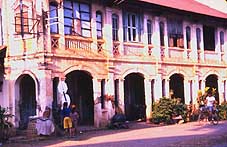 On
the road to Hue On
the road to Hue
I got to know a group of about six backpackers past the
“Where are you from?” “Where’ve you been?” “What’s your name?”
stages as we waited for the two hours past the departure time for the bus crew
to finish piling boxes onto the roof, into all the storage compartments, and
interestingly inside the bus itself (we would find out where they went very
shortly.) Around midnight we were finally allowed to board, and to our surprise
and shock and dismay, we discovered that every inch of floor space was filled
with boxes, so that the box height was the same level as the seats.
Two girls from England and I had to share a seat made for
two small people, and our knees were bent up to our chins. Boxes were piled in
the aisles as well so at least the third person in the seat could half-sit on
the seat, half-sit on a box (they were of the same softness and comfort, too.)
As we moaned and complained to each other about the standards of travel in
South East Asia, more and more people crammed onto the bus until it was so
full, people were sitting in the aisles.
Finally we were on our way.
After about half an hour we hit the bad road I had been
warned about which was so cratered with potholes the bus slowed to a crawl,
rocking from side to side. It was then people started getting sick. The stench
was so bad we had to open the windows but it was so cold, the two English girls
and I had to cling to each other for warmth (not that it was too difficult
since we were squished together).
That long night was punctuated by feelings of needing to
sleep so badly it hurt but knowing it was impossible, to actually nodding off
but waking suddenly when the bus hit a bump and my nose connected with the
shoulder of the girl next to me, or when the man singing on the stereo hit a
particularly high-pitched wail. At one point the three of us thought it may be
more comfortable if we lay length-wise along the seat and boxes, and it worked
for a while, us curled up almost on top of one another. Then nature called, the
bus rolled to a stop, and we crawled over bodies, boxes, and bags to stretch
our sore muscles and numb bums, and pee by the side of the road.
We finally arrived at the border around 8 a.m., looking like
we’d spent a week on the bus let alone the night. Maybe that’s why it took
us three hours to get through Lao and Vietnamese immigration and why we had our
bags searched on the Vietnam side. We all got to see what was in our toiletry
bags and what our dirty underwear looked like.
The bus suffered two flat tires on our way to Hue from Lao
Bao but the added delays didn’t even faze us. We’d been through hell
already - at least we could get off the bus and stand.
We pulled into Hue at about 5 p.m. and I said goodbye to my
new friends and other fellow travellers I had got to know so well. In fact, I
felt like I had known them for years rather than a day, and I felt sad. I guess
when you’re thrown in with a group of people for a relatively short period of
time, you make up for lost time by getting to know each other quickly. It’s
comforting to know then that you can find friends anywhere.
Looking back on that night from hell, when sheer discomfort
made sleep next to impossible, the importance of trust and faithfulness in
friendship was realized when my new-found friends and I lay curled up together
on that rock-hard seat. It was only then I could finally fall asleep. At least
for a few minutes.
Updated every Friday
Copyright 2001 Pattaya Mail Publishing Co.Ltd.
370/7-8 Pattaya Second Road, Pattaya City, Chonburi 20260, Thailand
Tel. 66-38 411 240-1, 413 240-1, Fax: 66-38 427 596
Updated by
Chinnaporn Sangwanlek, assisted by Boonsiri Suansuk.
E-Mail: [email protected]
|
|